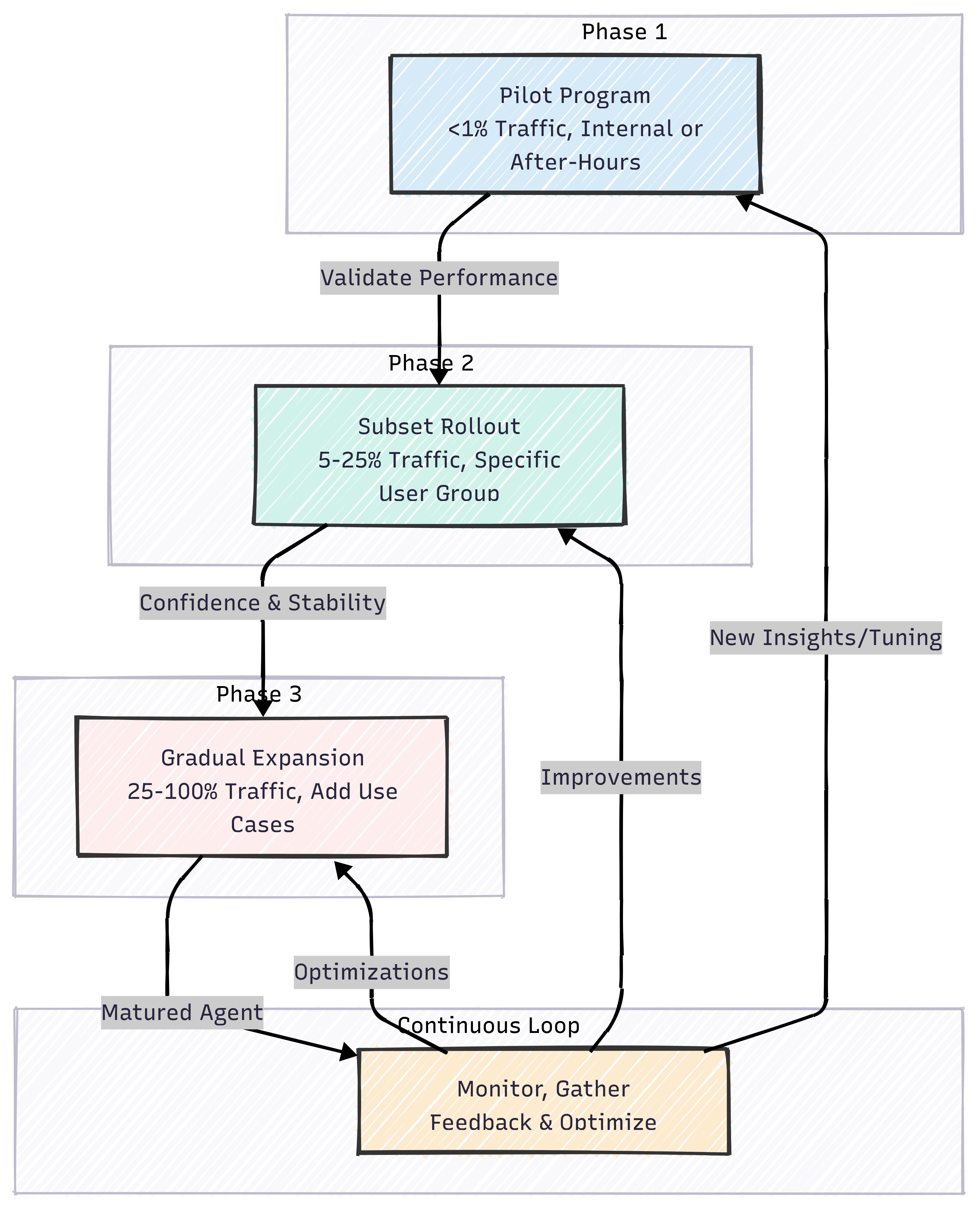
الموارد
Test, Tune, Repeat: The Real World Guide to Building and Scaling AI Voice Agents
Part 3: The Launch Strategy: Voice Agent Rollout & Customer Readiness

July 7, 2025
3 Minutes
Test, Tune, Repeat: The Real World Guide to Building and Scaling AI Voice Agents
You've deconstructed the AI stack and navigated the "Cloud of Problems" with a rigorous testing pipeline. Your agent performs flawlessly in the lab. The temptation now is to flip the switch and go live. However, this final phase, the rollout, is where even the most technologically sound projects can fail. Success depends not just on the quality of your AI, but on how you introduce it to your organization and your users.
This is not a simple deployment; it is a change management process. It requires a disciplined strategy, realistic expectations, and a deep understanding that you are introducing a new kind of workforce, not just a new piece of software.
The First Pitfall: Testing the Agent Like a Human
Before launch, stakeholders will want to "kick the tires." This is where the most common and dangerous misconception arises: testing the agent as if it were a human. This often looks like:
- "Let's ask it weird, unrelated questions." Stakeholders might ask about the weather or the meaning of life to see how "smart" it is. This is not a valid test. The agent was built for a specific task (e.g., booking appointments), not for open-domain conversation. This is like testing a calculator by asking it to write a poem.
- "It failed to handle this complex insurance complaint, it won't work." Voice agents are designed for predictable flows. Throwing a highly nuanced, emotionally charged, or novel edge case at it and expecting perfect performance is a recipe for disappointment.
An AI voice agent is a crafted system, not a conscious entity. It excels at its trained tasks and should be evaluated on its ability to perform them efficiently and reliably. The goal is not to build a universal AI, but to solve a specific business problem.
The Solution: A Gradual, Contained Rollout Strategy
Even with thorough testing, you cannot anticipate every real-world scenario. Therefore, you must de-risk the launch by deploying in controlled phases. A "big bang" release, where the agent is suddenly handling all traffic, often leads to unpleasant surprises and can erode user trust if issues occur.
The recommended approach is a phased rollout funnel that allows you to monitor, learn, and adjust in a controlled manner.

- Stage 1: The Pilot Program (The Quiet Phase): Start by deploying the agent to a small, controlled environment. This could be on a specific channel (like after-hours calls only), for a limited set of simple call types, or for a small group of internal users. This phase is not about handling volume; it's a learning period. The goals are to:
- Gather data on real-world user phrasing and behavior.
- Identify unforeseen issues and edge cases.
- Involve human agents to listen to calls, provide feedback, and act as a safety net for warm hand-offs.
- Gather data on real-world user phrasing and behavior.
- Stage 2: Gradual Expansion: Once the agent performs reliably in the pilot, begin routing more traffic to it. You might expand from 5% of calls to 25%, or add a few more call queues. Throughout this stage, maintain a tight feedback loop: continuously monitor logs, track key metrics (like containment rate and user satisfaction), and refine the agent's logic and responses based on real interactions.
- Stage 3: Full Production & Continuous Improvement: As confidence grows and performance stabilizes, you can roll the agent out to handle 100% of its designated traffic. But the work isn't done. The rollout strategy transitions into a continuous improvement cycle. As one voice expert put it, "The launch is just the beginning of the journey."
Customer Readiness: Setting the Right Expectations
Technology is only half the battle. Successful adoption requires educating your teams and stakeholders.
The Golden Rules of Voice AI Adoption
- AI Agents are Efficiency Boosters, Not Replacements. Set the expectation that the agent's role is to augment human teams by handling routine tasks, freeing them up for high-value work. This fosters buy-in rather than fear.
- Define Success with Metrics, Not Feelings. Don't ask, "Is it smart?" Instead, ask, "Did it improve our First-Call Resolution by 10%?" or "Did it reduce customer wait times?" Every agent should have clear, measurable KPIs tied to business outcomes.
- Design for Progress, Not Perfection. The voice AI ecosystem is rapidly evolving. Treat each model update as an experiment. Measure its impact, learn from it, and refine again. Embrace an iterative mindset.
Conclusion: The Journey to a Scalable Voice AI
We've journeyed from understanding the core AI stack, to navigating the "Cloud of Problems" with a disciplined testing pipeline, and finally to executing a strategic rollout. The central theme is clear: building a successful, scalable voice agent is not a single project, but a continuous, iterative process.
It requires a unique blend of technical expertise, business acumen, and psychological insight. You must understand the technology, from the ASR pipeline to the SIP trunk. You must have the discipline to test for the chaotic realities of human speech. And you must have the foresight to manage expectations, positioning the agent as a powerful tool that works in harmony with your human team.
A well-tested, well-tuned voice AI can delight customers with quick, accurate service and provide a level of convenience and accessibility that was not possible before. By prioritizing inclusive design, comprehensive testing, and a commitment to continuous improvement, teams can fulfill the promise of making technology more natural, accessible, and intuitive for everyone.
In summary: Test thoroughly, listen to your users (and your data), and never stop improving. An AI voice agent is a dynamic product, nurture it with ongoing development, and it will reward you with loyal users and efficient operations.

